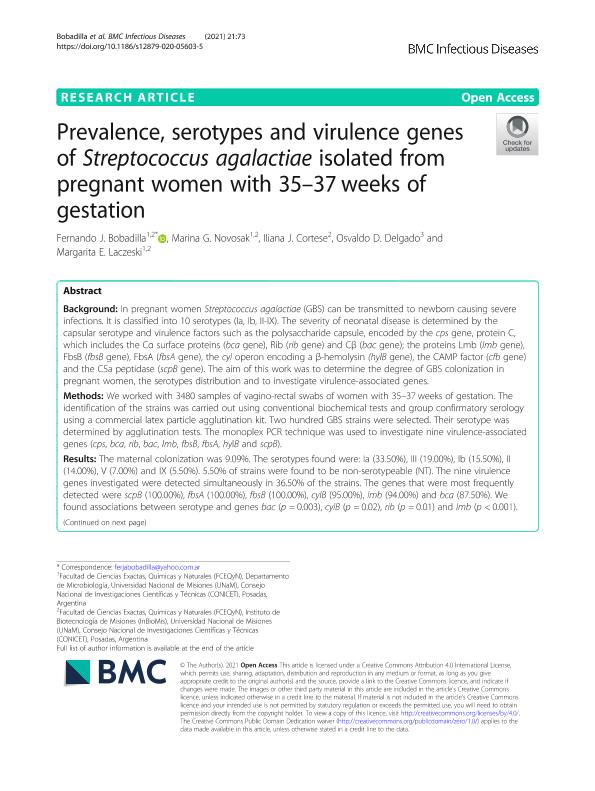Mostrar el registro sencillo del ítem
dc.contributor.author
Bobadilla, Fernando Javier

dc.contributor.author
Novosak, Marina Gisel

dc.contributor.author
Cortese, Iliana Julieta

dc.contributor.author
Delgado, Osvaldo Daniel

dc.contributor.author
Laczeski, Margarita Ester

dc.date.available
2021-06-15T13:47:12Z
dc.date.issued
2021-12
dc.identifier.citation
Bobadilla, Fernando Javier; Novosak, Marina Gisel; Cortese, Iliana Julieta; Delgado, Osvaldo Daniel; Laczeski, Margarita Ester; Prevalence, serotypes and virulence genes of streptococcus agalactiae isolated from pregnant women with 35–37 weeks of gestation; BioMed Central; BMC Infectious Diseases; 21; 1; 12-2021; 1-11
dc.identifier.issn
1471-2334
dc.identifier.uri
http://hdl.handle.net/11336/133884
dc.description.abstract
Background: In pregnant women Streptococcus agalactiae (GBS) can be transmitted to newborn causing severe infections. It is classified into 10 serotypes (Ia, Ib, II-IX). The severity of neonatal disease is determined by the capsular serotype and virulence factors such as the polysaccharide capsule, encoded by the cps gene, protein C, which includes the Cα surface proteins (bca gene), Rib (rib gene) and Cβ (bac gene); the proteins Lmb (lmb gene), FbsB (fbsB gene), FbsA (fbsA gene), the cyl operon encoding a β-hemolysin (hylB gene), the CAMP factor (cfb gene) and the C5a peptidase (scpB gene). The aim of this work was to determine the degree of GBS colonization in pregnant women, the serotypes distribution and to investigate virulence-associated genes. Methods: We worked with 3480 samples of vagino-rectal swabs of women with 35–37 weeks of gestation. The identification of the strains was carried out using conventional biochemical tests and group confirmatory serology using a commercial latex particle agglutination kit. Two hundred GBS strains were selected. Their serotype was determined by agglutination tests. The monoplex PCR technique was used to investigate nine virulence-associated genes (cps, bca, rib, bac, lmb, fbsB, fbsA, hylB and scpB). Results: The maternal colonization was 9.09%. The serotypes found were: Ia (33.50%), III (19.00%), Ib (15.50%), II (14.00%), V (7.00%) and IX (5.50%). 5.50% of strains were found to be non-serotypeable (NT). The nine virulence genes investigated were detected simultaneously in 36.50% of the strains. The genes that were most frequently detected were scpB (100.00%), fbsA (100.00%), fbsB (100.00%), cylB (95.00%), lmb (94.00%) and bca (87.50%). We found associations between serotype and genes bac (p = 0.003), cylB (p = 0.02), rib (p = 0.01) and lmb (p < 0.001). Conclusions: The frequency of vaginal-rectal colonization, serotypes distribution and associated virulence genes, varies widely among geographical areas. Therefore, epidemiological surveillance is necessary to provide data to guide decision-making and planning of prevention and control strategies.
dc.format
application/pdf
dc.language.iso
eng
dc.publisher
BioMed Central

dc.rights
info:eu-repo/semantics/openAccess
dc.rights.uri
https://creativecommons.org/licenses/by/2.5/ar/
dc.subject
COLONIZATION
dc.subject
GBS
dc.subject
SEROTYPES
dc.subject
VIRULENCE GENES
dc.subject.classification
Bioquímica y Biología Molecular

dc.subject.classification
Medicina Básica

dc.subject.classification
CIENCIAS MÉDICAS Y DE LA SALUD

dc.title
Prevalence, serotypes and virulence genes of streptococcus agalactiae isolated from pregnant women with 35–37 weeks of gestation
dc.type
info:eu-repo/semantics/article
dc.type
info:ar-repo/semantics/artículo
dc.type
info:eu-repo/semantics/publishedVersion
dc.date.updated
2021-06-10T19:22:43Z
dc.identifier.eissn
1471-2334
dc.journal.volume
21
dc.journal.number
1
dc.journal.pagination
1-11
dc.journal.pais
Reino Unido

dc.journal.ciudad
Londres
dc.description.fil
Fil: Bobadilla, Fernando Javier. Universidad Nacional de Misiones; Argentina. Consejo Nacional de Investigaciones Científicas y Técnicas. Centro Científico Tecnológico Conicet - Nordeste; Argentina
dc.description.fil
Fil: Novosak, Marina Gisel. Consejo Nacional de Investigaciones Científicas y Técnicas. Centro Científico Tecnológico Conicet - Nordeste; Argentina. Universidad Nacional de Misiones; Argentina
dc.description.fil
Fil: Cortese, Iliana Julieta. Consejo Nacional de Investigaciones Científicas y Técnicas. Centro Científico Tecnológico Conicet - Nordeste; Argentina. Universidad Nacional de Misiones; Argentina
dc.description.fil
Fil: Delgado, Osvaldo Daniel. Universidad Nacional de Catamarca; Argentina. Consejo Nacional de Investigaciones Científicas y Técnicas. Centro Científico Tecnológico Conicet - Tucumán. Planta Piloto de Procesos Industriales Microbiológicos; Argentina
dc.description.fil
Fil: Laczeski, Margarita Ester. Consejo Nacional de Investigaciones Científicas y Técnicas. Centro Científico Tecnológico Conicet - Nordeste; Argentina. Universidad Nacional de Misiones; Argentina
dc.journal.title
BMC Infectious Diseases

dc.relation.alternativeid
info:eu-repo/semantics/altIdentifier/url/https://link.springer.com/article/10.1186/s12879-020-05603-5
dc.relation.alternativeid
info:eu-repo/semantics/altIdentifier/doi/http://dx.doi.org/10.1186/s12879-020-05603-5
dc.relation.alternativeid
info:eu-repo/semantics/altIdentifier/url/https://bmcinfectdis.biomedcentral.com/articles/10.1186/s12879-020-05603-5
Archivos asociados
